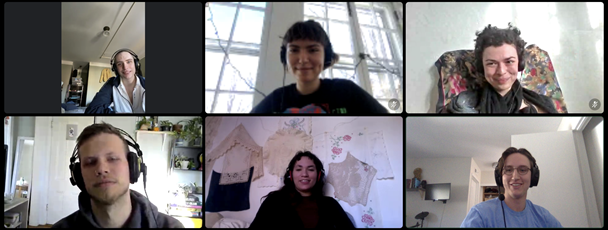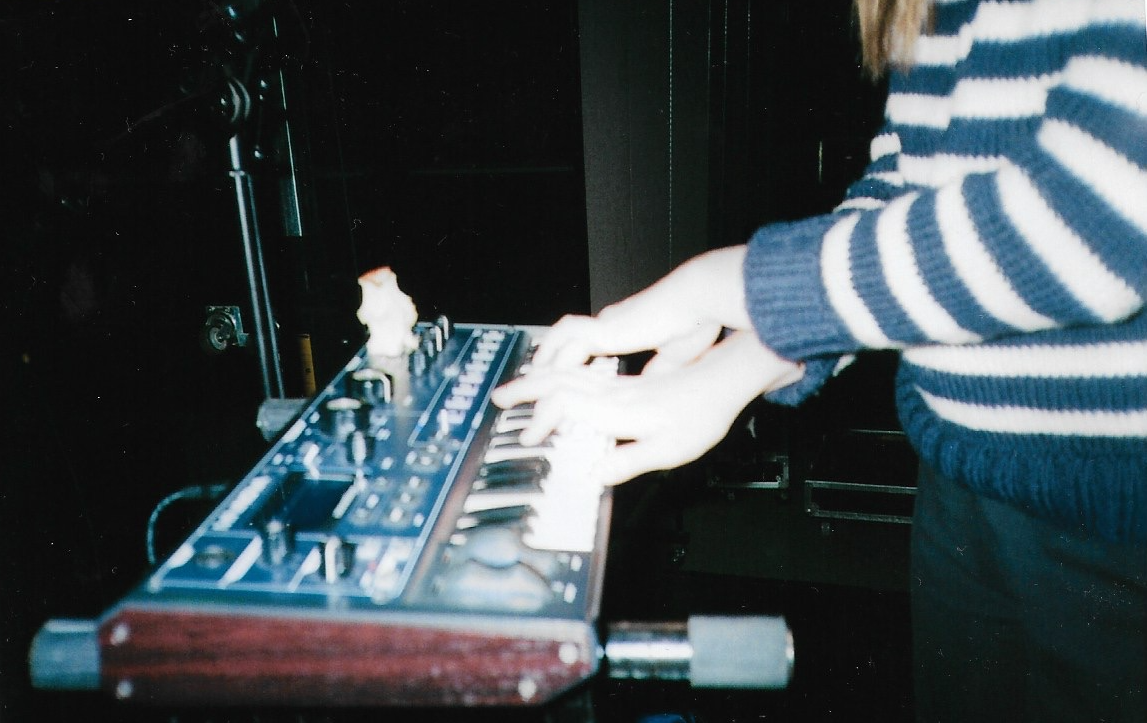I can’t put it any better than they do in their bio: “Milton Keynes makes room to dance in the midst of a dystopian empire.”
Milton Keynes is a six-person quarantine pop band with a mission to release one single a week for as long as they can. They started releasing at the beginning of February 2021, and each track has been marked by deftly curious maximalism, combining everything from soulful violin arrangements to Mario Kart-eseque beats to hyperpop rap about the “hedonist panopticon.”
I had to know more about how these polyinstrumental, genre-bending tunes came together, so I met with them on Discord to discuss the unique joys and difficulties of making music in the time of quarantine.
Slumber: My first question is about quarantine pop. “Quarpop” is a term that you’ve used to describe your music, and I understand what that means in terms of technical limitations, but does quarpop have a distinct sound?
Aubrey: I don’t know if it has exactly a specific sonic palate, but it has a particular quality to the structure of the songs. There are generally way more sections than there are to a normal pop song.
Celina: The way we think about how our music gets played and in what context it might be played, since everyone is alone and homebound, that affects the mood of our music. There’s a dark edge to it.
Kay: Lyrically too. I feel like a lot of our lyrics are reflective of what’s happening. Part of what makes pop music “pop” is that anyone can connect to it. We’re all living through this shared experience of this really specific, traumatizing time. So that’s the “quar” part.
Aubrey: Definitely. There [are] two sides to that; there are the darker elements, but also the escapist quality that our lighter songs have.
Slumber: Yeah, I can’t hop into anyone’s ride, but I can envision it.
Tom: It’s very disjoint, where each person’s trying to add their own take, and you’re not in the room to jam together. It adds, I don’t want to say a randomness, but somebody adds an instrument that maybe you wouldn’t add because you’re in your own influences.
Aubrey: It’s like remixing a remix of a remix, which can sometimes work super well. It’s certainly an emotional ride.
Kay: Also just the simple fact that this project wouldn’t have happened otherwise.
Aubrey: We have this sonic breadth, but also oddly there is a surprising amount of consistency. I don’t know if that’s what quarantine pop is.
Rohan: What’s interesting is that the actual music or compositions we’re doing are still in isolation basically. We’re not in communication when we’re adding to the songs. There is this seven-day period between where we’re actually collaborating and we have feedback and influence on each other’s work, which can definitely make things feel a bit disjointed. As the process goes on and we get towards completing a song, that’s where it’s been more stressful, because it gets more and more difficult to actually get everything to be cohesive.
Sonja: Also, I don’t know how it became, but we all listen to all of the tracks together. We sit down and we look at each other’s faces while we’re listening to each other’s music, and that’s what takes it from being made in isolation by many people to being quarantine pop, because you get serotonin watching your friends bopping along to some beats you made. That’s so important, and what makes me want to bring something festive and fun every week that we meet here. Or sad, but all different energies.

Slumber: How do you decide how songs come together? Do you have a parliamentary process? Is it just whatever gets tossed in the pot?
Celina: We piloted this idea of doing daisy chains, where each person comes with a demo, puts it in a Google folder, and there were six folders, each with a rearrangement of our names, and we just daisy chained every single song. That catalyzed a process of meeting weekly and listening to those daisy chains. Then other people started to bring in more demos, and it turned from the daisy chain process to more of a collective one. The more we worked together, the more we parsed out what our individual strengths are. So it was more regimented but it became more organic.
Aubrey: There’s a couple trending methods, and patterns. There are a lot of songs that began life like “I’ll mix an instrumental, and I’ll send it to one person, and they’ll write something and send it back to me.” I’ll send it off to someone, and we’ll build together like that. Then there are songs that have been old tunes someone has done [outside the group], and then they send them and then somebody else remixes it.
“[Milton Mondays] has given this project such longevity. There's no end date in sight for anything. We have this very simple goal that we want to achieve for as long as we can.”
Slumber: Are there other online tools that you’re using that seem fundamental to the creative practice? How do these digital boxes frame the creative content?
Tom: It forces us to make structures for ourselves. We have a Google spreadsheet of the songs we’re working on, who’s working on what, what needs to be added. Google Drive isn’t made for musicians, but we’re trying to make it work. We were joking before, if you were to look at our Google Drive, it is a mess, but we know. It’s like your room’s messy, but you know where all your shit is.
There is a tool out there called Splice I’ve wanted to look into that tries to bridge the gap between ppl who use different DAWs, because exporting the stems and sending those is sometimes difficult.
Sonja: It is interesting that they’re very unique problems we’re running into, and we’re trying to develop tools to fix them. Like the issue of matching vocals, when one person’s recorded vocals in their room, and then somebody else recorded in their room, and they sound like they’re in different places. We like the disjointed, but we’re not trying to do it on accident.
Aubrey: And for each song, we have to stem it out each time. So there’s usually five to ten versions of any song. Just even keeping track of that, and then we have almost 50 songs-
Slumber: Whoa, sorry to interrupt, but that’s a lot of songs!
Rohan: It’s probably more than that.
Aubrey: Yeah, we had to make a spreadsheet, because it was too hard to even remember what we had done.
Celina: We had phases as a band; there was a phase where it was really rooted in creation, just making and making, and then we started to slowly shift into that phase of sharing.
Rohan: We’ll show you our spreadsheet. There’s 45 in songs in progress in there, and there’s got to be 20 more that are just ideas. It’s fun because naturally, the songs we feel most excited about are the songs that end up being done. The ones we aren’t as excited about are replaced by songs we like more and want to finish more.
And about our technical issues with stems, while at certain times it has led to frustration, getting locked into these decisions is freeing, almost. You have to come to terms with things, get past your holdups. When we first started this project, we all expressed similar sentiments about having trouble finishing work. Pieces were always 80% done or whatever. Personally, this has just solved that issue, and it’s very freeing in that sense.
Also, by the way, Discord is pretty incredible. It’s definitely the best tool we use.
Celina: Yeah, because we have all these different channels for different purposes. The weekly meeting channel is this thing that just exists, you can pop in, pop out. Everything is in the same place.

Slumber: It’s also a unique way of using Discord. I know Discord as these huge servers with hundreds of gamers all chatting at once. Using it for a small group seems ingenious to me.
Tom: You can take a lot of stuff from the computer science world, like using Discord to organize a remote technical team, using tools like Asana to mark progress. We can pull from the technical field because we’re forced to hang in the technical field.
Sonja: We’re also very thankful to have a computer scientist [Tom] in our group.
Slumber: So aside from the music itself, y’all are making tiktoks, album art, all this promo content. How did you decide on your aesthetic for that?
Sonja: Pretty wholehearted discussions and dialogues.
Rohan: All of our decisions as a group are made by the group or with everyone’s input who wants to have input. So all the marketing we talked about as a group at some point.
Aubrey: Partially, in quarantine pop fashion, it developed in response to the fact that we can’t take photos with each other. We needed to figure out some language that would work without any human contact.
The releasing a single every week thing grew out of the idea that… I had thought “I’m gonna make an album,” but by the time I got half the songs finished, I’d given up on the other half. It’s so hard to focus all of your attention on this massive project, whereas if we broke it up into “We only need to really finish one thing every week,” we could.
“We sit down and we look at each other's faces while we're listening to each other's music, and that’s what takes it from being made in isolation...to being quarantine pop, because you get serotonin watching your friends bopping along to some beats you made.”
Slumber: Yeah, I wanted to ask about Milton Mondays. Online, you’ve said you’re hoping to release a song a week “for as long as you can.” Will there be an album of Milton Mondays music at some point, or is that incidental?
Aubrey: That’s incidental. Digital culture or whatever. It’s all built around working remotely, streaming. Singles make way more sense in the age of streaming generally. We’re built around the internet.
Tom: Also, some of the songs may not fit well in a cohesive album, but are still good as standalones.
Kay: It’ll be cool as we release more tracks to see what fits together and how to craft a narrative arc. Which we do think about when releasing these singles; how do we show our range, and how do we shift in tone back and forth?
Aubrey: I like albums to be a cohesive work, somehow. I feel like working the way we are, that would be next to impossible. Everything we do is a beautiful corpse anyway, so it would just be that on a massive scale.
Celina: The way we work is all parts of the process at once, rather than sitting down, conceptualizing, and going in a stepwise fashion. It might be that we find some assemblage of songs that happen to fit together. That would be a more likely way for us to assemble an album rather than having a concept and building on top of that.
Aubrey: If we were able to all write together, in the future at some point, I could imagine us working on a piece like that.
Tom: We could also just pull a Drake and release a playlist, and that’s what it is.
Sonja: We are kind of doing that.
Rohan: It’s given this project such longevity. There’s no end date in sight for anything. We have this very simple goal that we want to achieve for as long as we can. We have a lot of songs to finish, so there’s no reason for us to put out a project and then stop for a while. Singles are the perfect way to release based on the process.
Kay: It feels creatively sustainable. We get energy from working together. I wish I could be doing this full-time. We all have other things going on too. Jobs, school. We all put in what we can when we can, and that’s cool.
Slumber: One more question: do you have “post quarantine” plans as a band?
Sonja [laughing]: 100,000 streams of Milton Keynes.
Rohan: Our ultimate goal is to perform live in Milton Keynes together.
Tom: That and a way better website.

Listen to the official Milton Mondays playlist on Spotify:
Singer Joy is a queer musician, writer, and polytheist living in Providence, RI. She makes flowery anarchist theatre with her company Water House Collective, and is also a professional composer for the stage, a zinester, an erotica artist, and a Gemini.


